Dmitry Krotov
Dense Associative Memory with Epanechnikov Energy
Jun 12, 2025Abstract:We propose a novel energy function for Dense Associative Memory (DenseAM) networks, the log-sum-ReLU (LSR), inspired by optimal kernel density estimation. Unlike the common log-sum-exponential (LSE) function, LSR is based on the Epanechnikov kernel and enables exact memory retrieval with exponential capacity without requiring exponential separation functions. Moreover, it introduces abundant additional \emph{emergent} local minima while preserving perfect pattern recovery -- a characteristic previously unseen in DenseAM literature. Empirical results show that LSR energy has significantly more local minima (memories) that have comparable log-likelihood to LSE-based models. Analysis of LSR's emergent memories on image datasets reveals a degree of creativity and novelty, hinting at this method's potential for both large-scale memory storage and generative tasks.
Memorization to Generalization: Emergence of Diffusion Models from Associative Memory
May 27, 2025Abstract:Hopfield networks are associative memory (AM) systems, designed for storing and retrieving patterns as local minima of an energy landscape. In the classical Hopfield model, an interesting phenomenon occurs when the amount of training data reaches its critical memory load $- spurious\,\,states$, or unintended stable points, emerge at the end of the retrieval dynamics, leading to incorrect recall. In this work, we examine diffusion models, commonly used in generative modeling, from the perspective of AMs. The training phase of diffusion model is conceptualized as memory encoding (training data is stored in the memory). The generation phase is viewed as an attempt of memory retrieval. In the small data regime the diffusion model exhibits a strong memorization phase, where the network creates distinct basins of attraction around each sample in the training set, akin to the Hopfield model below the critical memory load. In the large data regime, a different phase appears where an increase in the size of the training set fosters the creation of new attractor states that correspond to manifolds of the generated samples. Spurious states appear at the boundary of this transition and correspond to emergent attractor states, which are absent in the training set, but, at the same time, have distinct basins of attraction around them. Our findings provide: a novel perspective on the memorization-generalization phenomenon in diffusion models via the lens of AMs, theoretical prediction of existence of spurious states, empirical validation of this prediction in commonly-used diffusion models.
Small Models, Smarter Learning: The Power of Joint Task Training
May 23, 2025Abstract:The ability of a model to learn a task depends strongly on both the task difficulty and the model size. We aim to understand how task difficulty relates to the minimum number of parameters required for learning specific tasks in small transformer models. Our study focuses on the ListOps dataset, which consists of nested mathematical operations. We gradually increase task difficulty by introducing new operations or combinations of operations into the training data. We observe that sum modulo n is the hardest to learn. Curiously, when combined with other operations such as maximum and median, the sum operation becomes easier to learn and requires fewer parameters. We show that joint training not only improves performance but also leads to qualitatively different model behavior. We show evidence that models trained only on SUM might be memorizing and fail to capture the number structure in the embeddings. In contrast, models trained on a mixture of SUM and other operations exhibit number-like representations in the embedding space, and a strong ability to distinguish parity. Furthermore, the SUM-only model relies more heavily on its feedforward layers, while the jointly trained model activates the attention mechanism more. Finally, we show that learning pure SUM can be induced in models below the learning threshold of pure SUM, by pretraining them on MAX+MED. Our findings indicate that emergent abilities in language models depend not only on model size, but also the training curriculum.
Dense Associative Memory Through the Lens of Random Features
Oct 31, 2024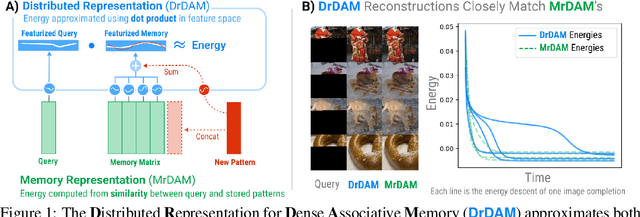

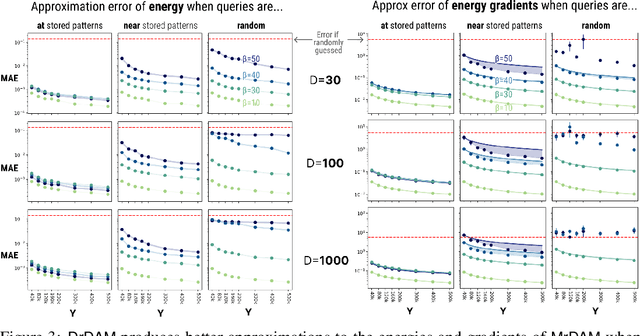
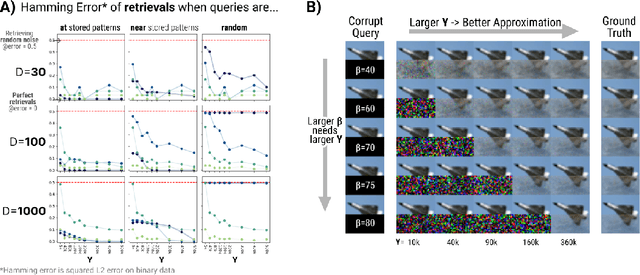
Abstract:Dense Associative Memories are high storage capacity variants of the Hopfield networks that are capable of storing a large number of memory patterns in the weights of the network of a given size. Their common formulations typically require storing each pattern in a separate set of synaptic weights, which leads to the increase of the number of synaptic weights when new patterns are introduced. In this work we propose an alternative formulation of this class of models using random features, commonly used in kernel methods. In this formulation the number of network's parameters remains fixed. At the same time, new memories can be added to the network by modifying existing weights. We show that this novel network closely approximates the energy function and dynamics of conventional Dense Associative Memories and shares their desirable computational properties.
Losing dimensions: Geometric memorization in generative diffusion
Oct 11, 2024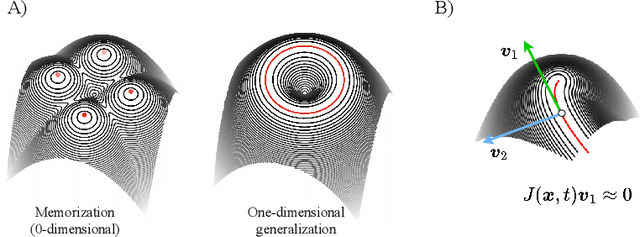

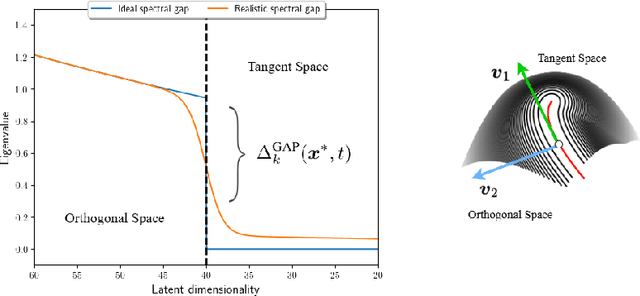

Abstract:Generative diffusion processes are state-of-the-art machine learning models deeply connected with fundamental concepts in statistical physics. Depending on the dataset size and the capacity of the network, their behavior is known to transition from an associative memory regime to a generalization phase in a phenomenon that has been described as a glassy phase transition. Here, using statistical physics techniques, we extend the theory of memorization in generative diffusion to manifold-supported data. Our theoretical and experimental findings indicate that different tangent subspaces are lost due to memorization effects at different critical times and dataset sizes, which depend on the local variance of the data along their directions. Perhaps counterintuitively, we find that, under some conditions, subspaces of higher variance are lost first due to memorization effects. This leads to a selective loss of dimensionality where some prominent features of the data are memorized without a full collapse on any individual training point. We validate our theory with a comprehensive set of experiments on networks trained both in image datasets and on linear manifolds, which result in a remarkable qualitative agreement with the theoretical predictions.
CAMELoT: Towards Large Language Models with Training-Free Consolidated Associative Memory
Feb 21, 2024Abstract:Large Language Models (LLMs) struggle to handle long input sequences due to high memory and runtime costs. Memory-augmented models have emerged as a promising solution to this problem, but current methods are hindered by limited memory capacity and require costly re-training to integrate with a new LLM. In this work, we introduce an associative memory module which can be coupled to any pre-trained (frozen) attention-based LLM without re-training, enabling it to handle arbitrarily long input sequences. Unlike previous methods, our associative memory module consolidates representations of individual tokens into a non-parametric distribution model, dynamically managed by properly balancing the novelty and recency of the incoming data. By retrieving information from this consolidated associative memory, the base LLM can achieve significant (up to 29.7% on Arxiv) perplexity reduction in long-context modeling compared to other baselines evaluated on standard benchmarks. This architecture, which we call CAMELoT (Consolidated Associative Memory Enhanced Long Transformer), demonstrates superior performance even with a tiny context window of 128 tokens, and also enables improved in-context learning with a much larger set of demonstrations.
Memory in Plain Sight: A Survey of the Uncanny Resemblances between Diffusion Models and Associative Memories
Sep 28, 2023Abstract:Diffusion Models (DMs) have recently set state-of-the-art on many generation benchmarks. However, there are myriad ways to describe them mathematically, which makes it difficult to develop a simple understanding of how they work. In this survey, we provide a concise overview of DMs from the perspective of dynamical systems and Ordinary Differential Equations (ODEs) which exposes a mathematical connection to the highly related yet often overlooked class of energy-based models, called Associative Memories (AMs). Energy-based AMs are a theoretical framework that behave much like denoising DMs, but they enable us to directly compute a Lyapunov energy function on which we can perform gradient descent to denoise data. We then summarize the 40 year history of energy-based AMs, beginning with the original Hopfield Network, and discuss new research directions for AMs and DMs that are revealed by characterizing the extent of their similarities and differences
Long Sequence Hopfield Memory
Jun 07, 2023
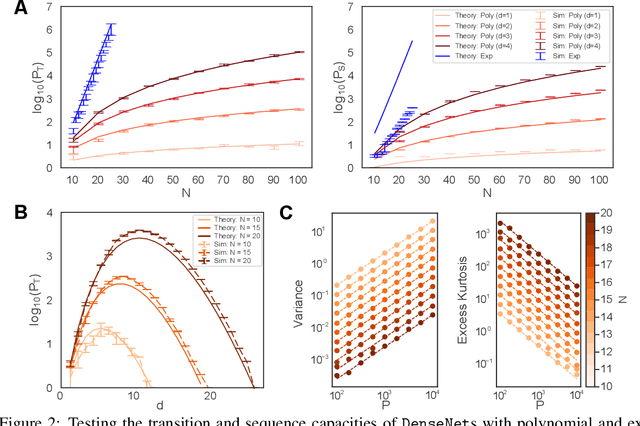
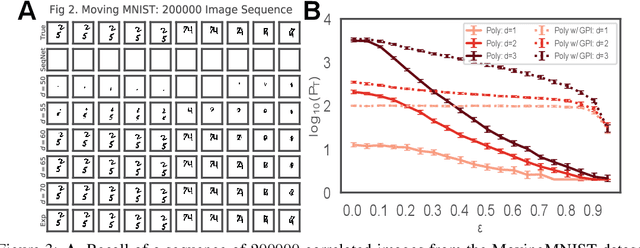
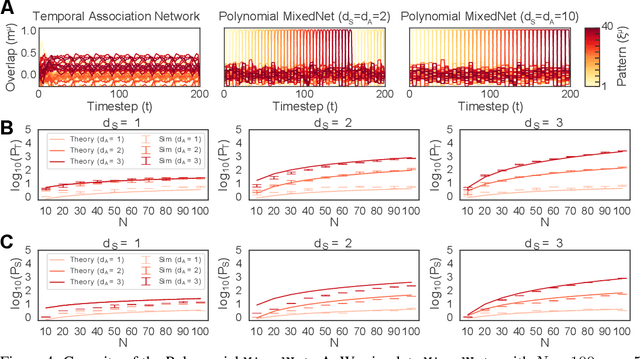
Abstract:Sequence memory is an essential attribute of natural and artificial intelligence that enables agents to encode, store, and retrieve complex sequences of stimuli and actions. Computational models of sequence memory have been proposed where recurrent Hopfield-like neural networks are trained with temporally asymmetric Hebbian rules. However, these networks suffer from limited sequence capacity (maximal length of the stored sequence) due to interference between the memories. Inspired by recent work on Dense Associative Memories, we expand the sequence capacity of these models by introducing a nonlinear interaction term, enhancing separation between the patterns. We derive novel scaling laws for sequence capacity with respect to network size, significantly outperforming existing scaling laws for models based on traditional Hopfield networks, and verify these theoretical results with numerical simulation. Moreover, we introduce a generalized pseudoinverse rule to recall sequences of highly correlated patterns. Finally, we extend this model to store sequences with variable timing between states' transitions and describe a biologically-plausible implementation, with connections to motor neuroscience.
End-to-end Differentiable Clustering with Associative Memories
Jun 05, 2023



Abstract:Clustering is a widely used unsupervised learning technique involving an intensive discrete optimization problem. Associative Memory models or AMs are differentiable neural networks defining a recursive dynamical system, which have been integrated with various deep learning architectures. We uncover a novel connection between the AM dynamics and the inherent discrete assignment necessary in clustering to propose a novel unconstrained continuous relaxation of the discrete clustering problem, enabling end-to-end differentiable clustering with AM, dubbed ClAM. Leveraging the pattern completion ability of AMs, we further develop a novel self-supervised clustering loss. Our evaluations on varied datasets demonstrate that ClAM benefits from the self-supervision, and significantly improves upon both the traditional Lloyd's k-means algorithm, and more recent continuous clustering relaxations (by upto 60% in terms of the Silhouette Coefficient).
Sparse Distributed Memory is a Continual Learner
Mar 20, 2023Abstract:Continual learning is a problem for artificial neural networks that their biological counterparts are adept at solving. Building on work using Sparse Distributed Memory (SDM) to connect a core neural circuit with the powerful Transformer model, we create a modified Multi-Layered Perceptron (MLP) that is a strong continual learner. We find that every component of our MLP variant translated from biology is necessary for continual learning. Our solution is also free from any memory replay or task information, and introduces novel methods to train sparse networks that may be broadly applicable.
* 9 Pages. ICLR Acceptance
 Add to Chrome
Add to Chrome Add to Firefox
Add to Firefox Add to Edge
Add to Edge